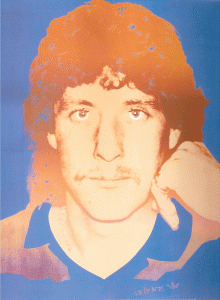« Features, Uncategorized
Push to Flush: The Goalkeeper Syndrome
By Paco Barragán
A confession: I’m a frustrated soccer player turned tennis aficionado. This explains why I can’t help but read from time to time certain surveys that appear in the world of sports revealing its competitive dynamics. Maybe my enthusiasm stems from the fact that one way or another they always end up referring to the equally competitive art world.
I remember reading an article in The New York Times in March, 2008 whose title strongly called my attention: “The Art of the Save, for Goalie and Investor.” Written by Patricia Cohen, basically what it said was that “when it comes to choosing what to do [during a downturn], the best thing is nothing.”
This apparent contradictio in terminis described the tensions that people undergo when forced to make a decision. And goalkeepers who have to stop penalties, deciding in a split-second which side of the net they have to choose, are par excellence not only high-motivated decision makers, but also very experienced ones. Now this dilemma between action or inaction-between moving to one side or staying in the center in case of the goalkeeper-plays an important role in our daily lives, especially in times of crisis like these.
DOING NOTHING
Now think art fairs. Art fairs used to be the sanctuary of the art world: the ultimate place for shopping, entertaining, and social networking; the place where Damian Hirst, Lou Reed, Sam Keller and the like enjoyed a mojito side-by-side at Le Baron in South Beach.
Then the economic tsunami came and destroyed whole banks and companies, and made even Wall Street shake. What happened to art fairs? Did they do anything to stay in business?
Even if the economy performs poorly and hits its clients badly, especially emerging galleries, nothing indicates that art fairs and their directors are tempted to move and do something else, so I firmly conclude that they must have good working knowledge of this article’s concept.
Now if the art directors were all European, I could understand it, as we Europeans have always, for better or worse, preferred contemplation to action. (Remember for example Formula 1 and its processional races as opposite to NASCAR, where the drivers go for it all the time!) Now again it is the Americans who decided to move to one side: The Armory Show, Art Chicago and NEXT, VOLTA NY, and even Art Basel Miami Beach (ABMB), although Swiss-owned but subject to American zeitgeist, decided to enlarge the number of exhibitors. That’s quite a statement for the future!
For some reasons I thought that the economic crisis would herald the demise of the hyper-inflated art fair model betting on quality by mainly a) downsizing the number of participating galleries, b) showcasing better-presented booths, and, in some cases, c) reducing the price of booths. After all, I hear more and more experts say that “people are looking for content.” Does this mean that the actual flea market or mall model is coming to an end? Not really. Does this mean that quality is not important in a contracted market? Yes, but not enough.
KEEP MOVING
This explains why most art fairs prefer to stay still in order to keep moving. In fact, art fairs assume the role of a sophisticated realtor limiting himself to subletting space to his clients, that is, the gallery owners. And many times, it’s not difficult to share that feeling.
And what about galleries? Why do they keep moving from art fair to art fair even if at this point for many the costs outweigh the sales? Why do they insist on a model that is decapitalizing them as they lack the cash flow of major galleries?
In the last 10 years, the gallery system expanded by four, and the still unstoppable emergence of new art fairs -JUSTMadrid, Pinta London, Artrio, etc.-bears witness to it. Even if the quality has gone down in most art fairs, vacant slots left by deserters are quickly replaced by a long list of ‘reserves.’ And galleries still think that in today’s global art market, fairs are exclusively the only sales tools that allow them to access new markets and new collectors.
This brings us to the heart of the matter: are dealers not selling in the gallery anymore? The explanation is not easy, but it’s especially striking that galleries are spending more and more time at art fairs, filling in applications and managing logistics. Ask any dealer. And this implies obviously less ‘traditional’ gallery work.
And what about the goalkeeper? Should he choose sides or stay in the center and wait until the penalty has been shot? One of the few sportsmen to be immortalized by Andy Warhol was German goalkeeper Harald ‘Toni’ Schumacher. I’m not sure Warhol was a soccer freak, but Schumacher coincidentally holds the record for the most World Cup penalty shootout saves, with four. He saved two against France in 1982, and another two against Mexico in 1986.
The funny thing is that Toni didn’t have a clear strategy. Sometimes he jumped, and sometimes he stayed put, but he achieved success only in those cases where he decided to stay in the middle. But according to the same article, goalkeepers feel much worse about a goal being scored following from inaction. Not jumping caused them greater emocional regret!
But then again, art fair directors don’t play soccer, just the market, and they prefer to stay still instead of moving.
Paco Barragán is an independent curator and an arts writer based in Madrid. He is curatorial advisor to the Artist Pension Trust (APT), New York. Some of the shows he has curated most recently are “Cinema X: I Like to Watch,” MoCCA, Toronto, 2010; “The Non-Age,” Kunsthalle Winterthur, 2009. He is the author of The Art Fair Age (CHARTA, 2008) and editor of Sustainabilities (CHARTA, 2008).



































